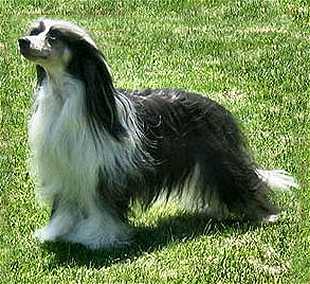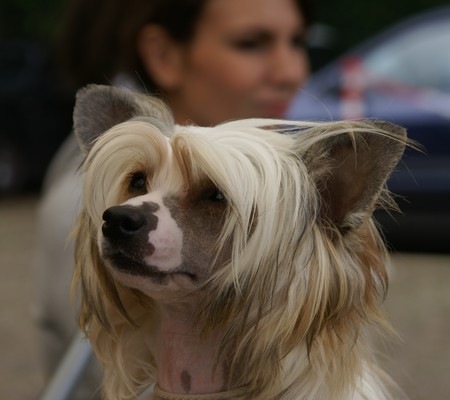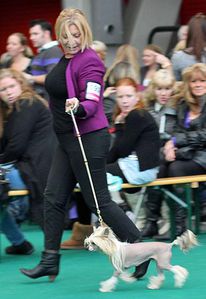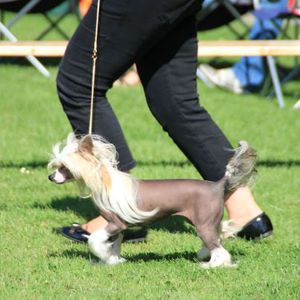voici une lecture en anglais tres interessante du standard expliquer avec photos ect ....
THE CHINESE CRESTED
Illustrated Standard

Explanation:
Scissors or level in both varieties. Missing teeth in the Powderpuff are to be faulted. The Hairless variety is not to be penalized for absence of full dentition.
Due to the hairless gene, the teeth in the Hairless may be smaller and the tiny "tusks" will extend forward, but the Powderpuff should have a regular canine mouth. These tusk-like teeth in the
Hairless may be due to a gene that often is seen with other mostly hairless mammals, such as the wild boar and the elephant. Selective breeding may help lessen the tooth problems of the
hairless.
Hairless: The Hairless mouth is different from that of a Powderpuff. The teeth of the Hairless variety differ in shape from those in a normal mouth. The canines are conical and point forward;
they are referred to as tusks. This is a characteristic which applies to both good and bad "Hairless" mouths.
The shape of the incisors can vary considerably. Some are no more than little pegs protruding from the gums. Others are almost normal. Sometimes a full complement of narrow "pegs" can look as
though they have been thrown in haphazardly. The number of teeth present can also vary. In the worst example, many may be missing, having never been present at all.
Occasionally, milk teeth which showed great promise are not replaced with adult teeth; and where milk teeth have been missing, adult teeth can appear! The teeth that are present can be poorly
rooted. For example, incisors may point forward like tusks, but they will certainly fall out at an early age. Pre-molars will be missing from the Hairless variety - one, two, or maybe all of
them. Even a good Hairless mouth may be without first and second pre-molars, and this should be accepted as normal. Tusks and missing pre-molars are not mentioned in the Standard, but these
characteristics should be acknowledged as typical of the Hairless mouth.
A successful breeding program to improve dentition will result in a mouth where all the incisors are evenly placed in each jaw. One or two pre-molars may be missing. The forward-pointing tusks
will still remain, but the teeth will be of better quality, and they will not fall out in eighteen months time.
An extremely "hairy" Hairless can look almost like a lightly-coated Powderpuff! They have even been referred to as "semi-coats", which makes things even more complicated for a newcomer to the
breed. In order to check whether such a dog is genetically Hairless or Powderpuff, simply look in the mouth. If the dog is genetically Hairless it will have forward-pointing tusks; if it is a
Powderpuff it will have a normal mouth.
Puff: The Powderpuff carries no Hairless genes, therefore it has a normal canine mouth, and their mouths are not affected by the Hairless gene mutation. At the front there are six incisors top
and bottom. The canine teeth are strong and slightly curved. Behind the canine teeth are four pre-molars and two molars, in both upper and lower jaws. This makes forty-two teeth in all, in a
tight scissor bite.
--------------------------------------------------------------------------------
FOREQUARTERS - Shoulders clean, narrow and well laid back. Legs long and slender, set well under body. Elbows held close to body. Pasterns fine, strong, nearly vertical. Toes turned neither in
nor out.



--------------------------------------------------------------------------------
BODY - Medium to long. Supple. Chest rather broad and deep, not barrel-ribbed. Breast bone not prominent. Brisket extending to elbows; moderate tuck-up.
Explanation:
The body is rectagular, measured from the withers to the base of tail slightly is longer than the height at the withers. The topline is "table top" level from behind the withers to the set-on of
tail without the pin bones showing.


--------------------------------------------------------------------------------
TAIL - Set high, carried up or out when in motion. Long and tapering, fairly straight, not curled or twisted to either side, falling naturally when at rest. Plume long and flowing, confined to
lower two-thirds of tail. Sparse plume acceptable.
 Correct
Correct
 Correct
Correct
 Correct - at rest
Correct - at rest
Explanation: The tail may point forward towards the head when on the move. The tip of the tail must never turn down towards the back, or touch the topline. ( Do not confuse the foward falling
plume, as part of the loop ) The tail itself must not curl over the back or form a ring (teapot tail).
--------------------------------------------------------------------------------
HINDQUARTERS - Rump well - rounded and muscular, loins taut, stifles firm and long, sweeping smoothly into the well let-down hock. Angulation of the rear limb must be such as to produce a level
back. Hind-legs set wide apart.


--------------------------------------------------------------------------------
FEET - Extreme hare foot, narrow and very long, with unique elongation of small bones between joints, especially in forefeet, which almost appear to possess an extra joint. Nails any colour,
moderately long. Socks ideally confined to toes, but not extending above top of pastern. Feet turning neither in nor out.
Drawings adapted from the book Canine Terminology by Harry Spira

Cat Foot
Unacceptable

Hare Foot
Acceptable but not desired

Elongated Hare Foot
Desired CC foot
Explanation:
This is a characteristic of the Chinese Crested and is fast disappearing from the breed. To ensure it remains it must be checked. Like many dogs the Chinese Crested hates to have its feet
touched, so to examine them without upsetting the dog, just pick it up as you would a horse's foot and bend it backwards. You can soon see the distance from the foot pad to the toe pads from
underneath.
A cat foot will have the foot pad and the toe pad relatively close together. (See above illustration)
A hare foot will have the toe pads a longer distance from the main foot pad. (See above illustration)
An elongated hare foot will have even more distance from the main foot pad. (See above illustration)
--------------------------------------------------------------------------------
COLOUR - Any colour or combination of colours.
Explanation:
All colour including parti-coloured, solids,spotted and tri-coloured are permitted. The shades can range from pale to very rich. Don't let colour sway your judgment - judge for conformation first
and foremost!
COAT - No large patches of hair anywhere on body. Skin fine grained, smooth, warm to the touch. In Powder Puffs coat consists of an undercoat with soft veil of long hair, veil coat a feature.




Explanation:
Due to the variable expressivity of the hairless gene, it is almost impossible to eliminate sparse hair in the Crested. Selective breeding can help, but it is a feature we have to live with.
(Editor's note: The coat texture on both varieties is soft, silky and straight of moderate density and length. Thick, heavy, curly or kinky coats are not acceptable. Hair on the face and ears of
both varieties may be trimmed for neatness. Additional grooming to be kept at a minimum, and only to present a clean and neat appearance.)
Puff: The coat of the Powderpuff causes confusion. The Standard calls for an undercoat with a soft veil of long hair. It is only in recent years that a Powderpuff coat has been given real coat
care, so we are only just seeing the beauty of the mature coat. The length of the coat will vary: if the Hairless in the line have long crests, the coat will be long; if they are sparsely
crested, the coat will be thinner and shorter. The coat is made up of long, soft hairs with coarser guard hairs. When the dog is young these hairs are short and look like an undercoat, but by the
time the dog is eighteen months old, they grow through to create the so-called veil. In reality, this is not a very good description and it causes much confusion among judges and breeders. On a
well-groomed dog the guard hairs will mingle with the main coat and they will only show if they are a darker colour, which gives a very attractive appearance.
Hairless: An extremely hairy Hairless will fit the Standard, which has also led to confusion! There is another coat-type, which is seen occasionally. It is shorter and quite coarse. The ears are
also smaller than normal and are erect. These types are probably the result of mixed parentage, way back in the evolution of the breed. It is NOT a Powderpuff though, it is a HAIRY HAIRLESS and
will not have a normal mouth, but rather forward-pointing tusks.
--------------------------------------------------------------------------------




GAIT/MOVEMENT - Long, flowing and elegant with good reach and plenty of drive.
Explanation:
Movement is quick and lively without a hackney or mincing gait. Topline remains level.
SIZE -
Ideal height: Dogs 28-33 cm (11-13 ins) at withers
Bitches 23-30 cm (9-12 ins) at withers
Weight varies considerably, but should not be over 5.5 kg (12 lbs).
--------------------------------------------------------------------------------
For more photographs of Chinese Cresteds visit the Chinese Crested Database
Editors note: Many of the photographs above were taken off this website as examples of excellent type
If you do not wish to have your dog portrayed here please contact the webmaster
Article prepared by Judy Horton - (All Breeds judge) for the VicJudge's website Australia
avec les remerciements a Lorraine Chippindale pour cet article

HISTORY OF THE BREED
The Chinese Crested is believed to have evolved from the African hairless dogs. These dogs were traded among merchants and sailors thereby making their way to ancient port cities around the
world. The Chinese, who seemed to favor dogs of smaller size, selectively bred the African hairless to a smaller size and continued an active trade. Explorers, as early as the 1500s, found these
dogs in ports throughout Central and South America as well as African and Asian cities.
GENERAL APPEARANCE - A small, active and graceful dog; medium to fine boned, smooth hairless body, with hair on feet, head and tail only; or covered with a soft veil of hair.
Explanation:
The Chinese Crested is found in two varieties, Hairless and Powderpuff, and both types can be found in the same litter. The main difference between the two varieties is the hair coat, of course,
but the Powderpuffs can also have a drop ear, which is not permitted in the hairless variety. The Powderpuffs are not subject to as many genetic defects as their hairless siblings and need to be
retained in the breeding pool to maintain the health of the hairless Cresteds.
CHARACTERISTICS - Two distinct types of this breed; Deer type, racy and fine boned, and Cobby type, heavier in body and bone.
--------------------------------------------------------------------------------
HEAD AND SKULL - Slightly rounded and elongated skull. Cheeks cleanly chiselled, lean and flat, tapering into muzzle. Stop slightly pronounced but not extreme. Head smooth, without excess
wrinkles. Distance from base of skull to stop equal to distance from stop to tip of nose. Muzzle tapering slightly but never pointed, lean without flews. Nose a prominent feature, narrow in
keeping with muzzle. Any colour nose acceptable. Head presenting graceful appearance, with alert expression. Lips tight and thin; An ideal crest begins at the stop and tapers off down neck. Long
and flowing crest preferred, but sparse acceptable.




Explanation:
The head is wedge shaped when viewed from above. The skull itself is gently arched across the occiput from ear to ear. The stop is slight but distinct. The head is clean and free from
wrinkle.
--------------------------------------------------------------------------------
EARS - Set low: highest point of base of ear level with outside corner of eye. Large and erect, with or without fringe, except in Powder Puffs where drop ears are permissible.
--------------------------------------------------------------------------------
EYES - So dark as to appear black. Little or no white showing. Medium size, almond in shape. Set wide apart.
Explanation:
Eyes are dark in darker coloured dogs, but may be a little lighter in lighter coloured dogs, but blue, green, grey or yellow eyes are not acceptable.


EARS - Set low: highest point of base of ear level with outside corner of eye. Large and erect, with or without fringe, except in Powder Puffs where drop ears are permissible.

--------------------------------------------------------------------------------
MOUTH - Jaws strong, with perfect, regular scissor bite, i.e. the upper teeth closely overlapping the lower teeth and set square to the jaws.






